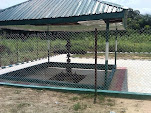MAINTENANCE OF TOOLS CONTINUES
Please ensure you keep all these information and strictly abide to it for all your work and house chores, afterall accidents are also recorded in the house.

4 � adjustable tensioning wheel
5 � drive wheel (connected to motor)
6 � band saw blade guide
8 � tensioning knob
9 � emergency switch
1 � stainless steel body
2 � stainless steel door
3 � stainless steel table
7 � safety cutting handle
Installation:
After being positioned at its designated place and levelled, the band saw must be assembled carefully. The body door (Fig. 404) (2) is opened and the band saw blade is pushed over the two wheels with the cutting teeth facing the door opening and fitted into the guide. By adjusting the upper wheel (4) with the tensioning knob (8), the tension of the blade is corrected to allow for a firm grip between wheels and blade. The band saw must be connected properly to the electrical power supply line. Care must be taken that the band saw blade rotates in the right direction, with the blade moving downwards at the exposed portion. The materials to be cut will be kept firmly on the table in this direction only (3).
During cutting operations, the material to be cut must always be moved on the table by using the safety cutting handle (7). The band saw must be cleaned frequently and disinfected at the end of daily operations. First the door is opened and the tensioner of the band saw blade released. The blade is taken out of the machine and cleaned separately and must be stored in a dry and safe place. All meat, bone and fat particles which have accumulated inside the space where the blade circulates must be removed and the machine cleaned thoroughly. The door should be kept open to avoid corrosion due to moisture.
Smokehouse
Simple smokehouses (Fig. 37, 41) do not require much maintenance. Care must be taken that the sawdust tray and ash collector are emptied and cleaned frequently. The smoke sticks and ceiling of the smokehouse must be kept free of tar to avoid unwanted tar-spots on the smoked products. The built-in exhaust opening, often equipped with a blower, must be cleaned frequently to avoid tar dripping onto the products.
More sophisticated smoking chambers follow various designs and can be equipped with a variety of additional fixtures and appliances. They need to be handled, cleaned and maintained according to the handbook provided by the supplier. For details on technical systems see pages 24, 25.
Equipment for personnel
The provision of hygienic equipment and personal protective equipments essential to prevent contamination of meat and meat products through contact with clothes, shoes or direct contact with hands or breath (see also chapter on Meat Processing Hygiene page 339). Some appliances and protective clothes, boots etc. also serve to protect workers from accidents.
Hygienic equipment and materials:
Protective clothing – To avoid contamination of workplaces, materials and products from street clothes, workers have to wear clean protective clothing. Either one-piece overalls or two piece sets are recommended as they cover the complete body. In some workplaces only overcoats are used with the disadvantage that the trousers/skirt is not covered.
Head gear – Human hair on equipment, materials and products must be avoided. Caps and/or hairnets are used to cover and contain hair.
Gloves – In meat processing, staff are encouraged to wear latex gloves to avoid direct contact of materials and products with hands. This is of special importance during packaging, when also mouth protection is recommended to avoid contamination of fresh and processed products .
Gum (rubber) or plastic boots – These boots are used to protect staff in meat operations from moisture. The sole design facilitates a firm grip on slippery surfaces. For easy detection of dirt, boots are usually white.
Plastic aprons – This type of apron is used to protect workers and their working clothes from moisture, meat and fat. Plastic aprons should be long enough to overlap the boots, thus allowing splash water to rinse off.
PLEASE LEAVE YOUR COMMENT ON THE COMMENT BOX






This message is good, guy you site is lovely. It gives insight about every sphere of life.
ReplyDeletekeep it up you are wonderful.